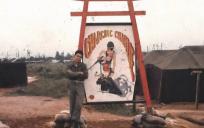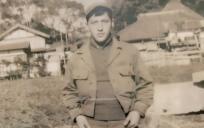
Record date:
Paul Baffico, First Lieutenant
Paul Baffico’s story of service truly represents the turmoil our nation faced in the early 1960s—a college student in San Franciso who chose to enroll in the ROTC as Americans were becoming more and more divided on the issue of the Vietnam War, Baffico served with the famed 101st Airborne Division in an area that saw heavy action, before returning home to a community that either couldn’t—or wouldn’t—understand what the military’s sacrifice had been about.
Differing from some of the public universities at the time, the school that Baffico attended—the University of San Francisco—had a requirement that all students participate in ROTC for their first two years with the option to continue on voluntarily after that. Despite the more conservative nature of the school, the university’s proximity to landmarks of 60s counter-culture—Haight-Ashbury, The University of California at Berkeley, and San Francisco itself—made putting on a uniform and going to class that much more intense in an environment where heated debates about Vietnam were raging. Watching as peers were pulled out of class and taken to the draft board, however, and hoping to postpone being drafted himself, Mr. Baffico chose to continue with ROTC after the school’s initial requirements had been met.
After completing his undergraduate studies, Baffico was trained as a Signal Officer at Ft. Gordon, Georgia before moving on to Ft. Sill, Oklahoma, and finally landing at Ft. Hood, Texas. From there, he deployed to Vietnam and joined up with the 101st Airborne Division as a Signal Platoon Leader at Camp Eagle, in the hotly contested DMZ. From the time he landed in Vietnam—coming into Tan Son Nhut and making the 30-minute drive by jeep to Camp Eagle—Baffico was enveloped by the dangers of the conflict that would be ever-present in his 206 combat assaults.
One day, in particular, stands out to Baffico and represents the intensity he experienced:
As dawn broke on the morning of May 6th [1970] I was called to Division Tactical Operations Center (the Situation Bunker) and told that Firebase Henderson was under heavy attack and partially overrun. It was a sapper attack and the ammo dump was on fire and cooking off. My three men had been hit: two killed and one MEDEVAC’d out. The battle was at full peak and the only working communications for the entire firebase was the Pathfinder radio (LZ air traffic control). I was ordered to get a new team and equipment ready and get them installed at Henderson within 45 minutes regardless of the situation. I was not to leave the firebase until my men were in place and the equipment was back on air.
That during his interview Baffico chooses to focus on issues of leadership surrounding this moment, and what it means to support the troops in such a situation, is perhaps telling of how hard it is to revisit certain moments in the past. Mr. Baffico does suggest it took him many years to be able to even write about that day. The understanding of leadership that Baffico took away with him that day continued to shape him as he came home to a community protesting the war in Vietnam; as he married and raised a family, and as he began a long career with Sears Roebuck & Co.—a company that understood his service and supported him.
Baffico, who lives in Lake Bluff, Illinois and is one of the founders of the Lake County Veterans and Family Service Foundation, takes time each month to volunteer at The Vietnam Veterans Memorial in Washington, D.C., where he talks with visitors about the war-time sacrifices he witnessed and what it actually means to be of service to your country.










